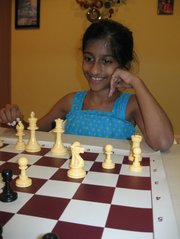At the age of 9, Aasa Dommalapati, a fourth-grader at Greenbriar West Elementary, competed against the top chess players in Brazil and Canada during the summer months. She is currently ranked fourth nationally in the girls U-9 category.
Representing the U.S. for U-10 girls, she took third against nine challengers at the Pan American Youth Chess Championship in Brazil. Then it was off to Toronto in mid-August where she competed in the North American Youth Chess Championships and placed 22 out of 31. She was also part of a team of 80 players from the U.S. who played in Slovenia last year -- her first international experience. She has qualified to play in Dubai at the World Youth Championship this coming December. The child wonder won her first national tournament in 2009 in Dallas while she was in Kindergarten.
Since that time she has been tutored on Skype by Vempati Kameswara Rao, 33, from Hyderabad, India, who also uses the website MyChessGuru.com. He has a FIDE rating of 2088 in the Worldwide Chess Federation and is a national arbiter for chess tournaments.
He calls Aasa an “attacking” player. “I’m expecting her to become a Woman Grandmaster,” he adds. “That is a long-term goal. The short-term goal is World Youth Champion.”
Aasa also gets help from her dad Anand, who was chairman of the Greenbriar West Elementary Chess Club for four years.
BEFORE TOURNAMENTS, he often takes three hours of prep time to coach and prepare his children to win. “Usually we don’t know these people,” said Anand. “We get a basic idea of what to expect … the coach can work with them to come up with an alternative solution and what to expect.”
For strategy, Aasa says she breaks down chess matches into three parts: openings, middle and end games. Her strategy is to use different tactics and attacks, she says: “We think of a plan and we just play it.”
If that doesn’t work, she says she tries another plan, and plays that. “And if he stops it, we think of another plan. And it goes on and on. And if he defends the plan, then we change it,” she adds.
During the Brazil tournament, she played nine rounds for almost four hours each. “I was expecting a little more, but I think I did pretty good,” said Aasa. “I played two U.S. players, from Washington state and California.”
Brother Abhinay, 14, is a freshman at Chantilly High who has been playing chess since second grade. He’s traveled all over the U.S. competing in state and national tournaments. He says he always learns something new with every chess game he plays. “I like to defend at first—then I like to attack when my opponent is not expecting,” he said. “I don’t just attack or defend—I do both.” At Rocky Run Middle, he maintained a 3.9 GPA and was in the e-Cyber Mission Club and Model U.N.
The GBW Chess Club, which is coached by Paul Swaney, meets Mondays and Thursdays for students in grades second through sixth. An advanced club has 20 students who meet on Mondays.
“We group the strong with the strong,” said Anand, of the Fair Lakes Crossing community, of organizing the club. He is a certified USCF—United State Chess Federation senior tournament director. He also works as an employee for BAE Systems, Inc.
FOR CHESS PRACTICES, he’ll organize five minutes of fast games called a “Blitz” just for fun. He also organizes simul-chess or simultaneous chess, and “Bug House,” or team chess for fun.
“Basically by doing that they get to play the stronger players,” he said. “So when one tournament is over, you’ll have players with four to zero points. Those with zero points get moved into another section where they are paired with others with similar strengths.
The GBW Chess Club is now taking registration for the new school year, with 90 children maximum. They are split into two groups that play from September through January, and then February through June. The 90 are split into five or six sections, with about 16 children in each section, based on ratings. On Thursdays, students play four rounds in a tournament. Students with the highest scores win trophies and medals. During the entire season, the club plays three to four tournaments.

